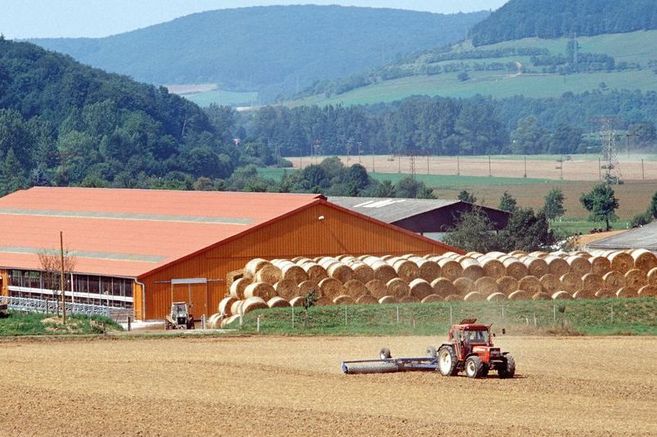Project
LAMASUS - LAnd use and MAnagement modelling for SUStainable governance
![[Translate to English:]](/media/_processed_/9/a/csm_2579_Lamasus-color-positive_761bcfb32d.png)
LAMASUS - LAnd use and MAnagement modelling for SUStainable governance
The EU is committed to achieving climate neutrality by 2050. The land use sector is important in terms of achieving these goals. But using land to capture carbon is not an easy option. EU policymakers have a tough job making choices for European agriculture and land use as well as climate change. In this context, the EU-funded LAMASUS project will build on decades of experience in direct policy support. It will develop a novel governance model based on multiple stakeholder dialogues, from European Commission level to local administrations.
Background and Objective
As part of the European Green Deal, the EU must achieve climate neutrality by 2050. The land use sector has a key role to play, which is recognized in the “Fit for 55 package”, where a climate neutrality target for the Agriculture, Forestry, and Other Land Use (AFOLU) is set for 2035. To enable fundamental transformations in the land use sector necessary to achieve the Green Deal, LAMASUS proposes a step change in land use sector governance from policy formulation to implementation to monitoring. LAMASUS builds on i) decades of experience in direct policy support, ii) unique modeling tools, such as GLOBIOM, the only model that integrates agricultural and land use sectors, and CAPRI, MAGNET and CLUE, which underlie JRC’s land use policy assessments, and iii) novel approaches mobilizing machine learning and citizen science.
The project is driven by four key elements:
- EVIDENCE – dynamic monitoring of land use, management and related policies for evaluation and model calibration;
- UNDERSTANDING – state-of-the-art econometric and biophysical models to assess the role of past policies on changes in land use and management, and their economic and environmental impacts;
- TOOLS – a highly-integrated policy modeling framework with full sectorial coverage from agriculture and forestry to the whole economy, accounting for carbon, biodiversity and all relevant sustainability dimensions, at multiple scales (land use actors, country, EU level, global);
- GUIDANCE – a multi-level stakeholder dialogue for co-design of agriculture, forestry and climate policies by the EC, national and local governments and citizens, made accessible to stakeholders across multiple spatial scales through the novel web-based LAMASUS Portal.
In this way, LAMUSUS will create a new level of societal engagement in which local actors contribute to the design of effective and efficient EU policies for climate neutrality and will serve as an exemplar for other policy processes within the European Green Deal.
Approach
The LAMASUS project aims to develop new tools for assessing the environmental and economic impacts of European land-use policies, by collecting historical data and analyzing the dynamics of land use changes. These tools will be used to model future policies and will be integrated into a science-based governance process involving stakeholders at different levels. The project is structured around four pillars:
- collecting new evidence
- understanding the dynamics of land use changes and their impacts
- developing modeling tools
- designing future policies in collaboration with stakeholders.
The ultimate goal is to provide a proof-of-concept for a new governance process based on quantitative modeling results.
The Thünen Institute is part of the pillars 1, 2 and 3.
Data and Methods
Main data expected to be used:
- Remote sensing (satellite imagery, aerial photography, drone imagery.
- Other spatially resolved data
- In-situ (visually interpreted interpreted) and field-based measurements
- Statistical data: Balance sheet data, agricultural structure survey, and agricultural census data
- Citizen observatories: community-based environmental monitoring and information systems, observations provided by individuals
Methods:
- Econometric methods
- Economic simulation and mathematical programming models
Our Research Questions
- Which factors determine the conversion from conventional to organic production?
- What role do neighborhood effects play in this process?
Links and Downloads
Thünen-Contact

Involved Thünen-Partners
Involved external Thünen-Partners
- International Institute for Applied Systems Analysis (IIASA)
(Laxenburg, Österreich) -
Rheinische Friedrich-Wilhelms-Universität Bonn
(Bonn, Deutschland) -
EuroCare GmbH
(Bonn, Deutschland) -
Stichting Wageningen Research (WEcR)
(Wageningen, Niederlande) - Institut national de recherche pour l’agriculture, l’alimentation et l’environnement (INRAE)
(Paris, Toulouse, Montpellier, Avignon, Ivry-sur-Seine, Clermont-Ferrand, Rennes, Thiverval-Grignon, Dijon, Orleans, Bordeaux, Pierroton, Frankreich) - Universität für Bodenkultur (BOKU)
(Wien, Österreich) - Wirtschaftsforschungsinstitut in Österreich (WIFO)
(Wien, Österreich) -
Freie Universität Amsterdam
(Amsterdam, Niederlande) - University of Valencia
(Valencia, Spanien) - Institute for Rural and Regional Research
(Trondheim, Norwegen)
Duration
9.2022 - 8.2026
More Information
Project status:
ongoing
Publications to the project
- 0
Neuenfeldt S, Gocht A, Renhart A, Sebbesen A, Mittenzwei K (2023) D3.1 Report on stocktake of requirements and technical specifications for the LUM policy database. vi, 52 p








